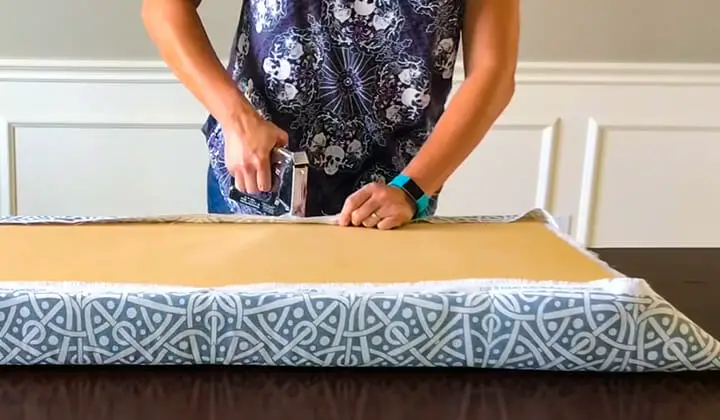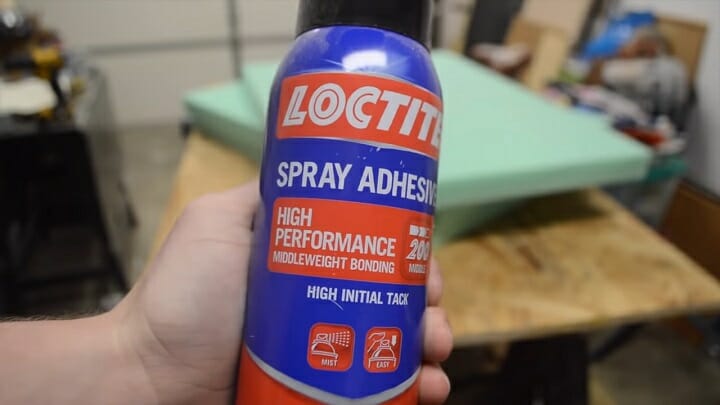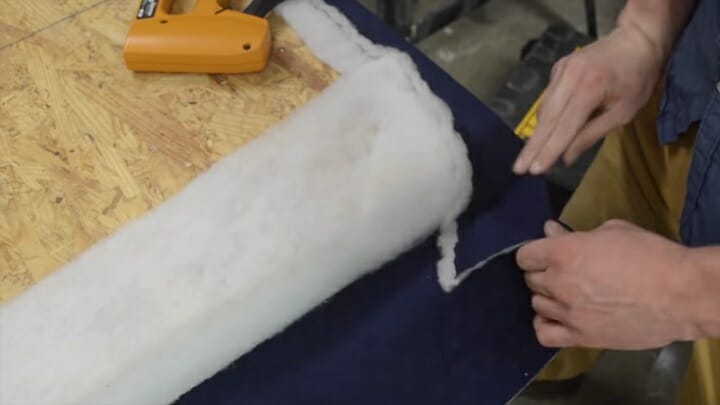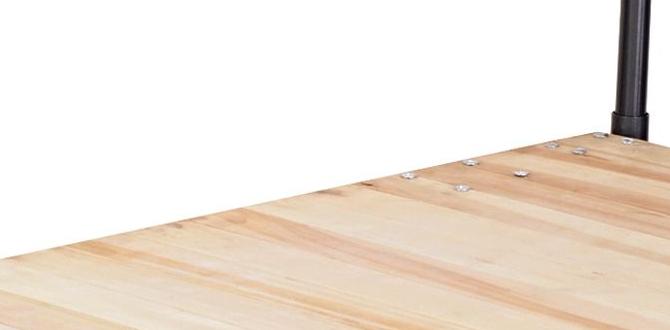To make a bench cushion, cut the plywood, foam, and batting according to the size of the top of your bench. Then attach them by using an adhesive spray and line them up correctly. After that, add fabric to them and do the corner carefully, just as we wrap up with gift paper. Finally, staple the fabric up to the plywood.
[aawp box=”B082R1PJTD” template=”vertical”]
Table of Contents
How to Make a Bench Cushion with Staple Gun
Making a bench cushion with a staple gun might be one of the easiest DIY projects of all. And if you want to keep it plain and have no sewing mark, it will need just a staple gun, and you are good to go.

The best thing about a bench cushion is that it is entirely separate from your bench, and you can remove it any time you want. So, you can make a bench cushion of any size, and still, it will fit your bench, storage bench, window seats, and outdoor or garden furniture.
Before we start talking about the steps, we’d like to go over a few things first- Required materials and Required equipment.
Required Materials
Even if you have got no experience with upholstery, it’s merely anything more than fun. But first up, gather wood, foam, fabric, and more.
1. Plywood
Well, what kind of wood you should pick, totally it is up to you. It does not matter a lot as this part of the bench cushion will not be seen as much as the other materials. So, you can choose a reasonable one from the market. As for our recommendation, we will suggest the ½ inch plywood.
When you buy plywood, you must have the correct dimension of the top of your bench. And you will not have to worry about cutting it as your shop might do it for you.
2. Upholstery Fabric
You should choose the fabric according to your usage. As there are dedicated fabrics for upholstery, you should not worry much about it. But if you are looking for materials for your garden bench cushion or outdoor cushions, then go with the outdoor fabrics.
And the amount of fabric depending on the size of the bench cushion. Usually, 2 yards of fabric should be enough for a decent size bench cushion.
3. Foam
As the density of foam matters a lot, you should check it out before buying the foam. Usually, medium-density foam of 3 inches thickness is good enough for this kind of project. And you should cut the foam according to the size of your bench.
The high-density foam is a lot more pricey than the low or medium-density cushions. So, you can go with the low-density cushions to save some extra bucks. Besides, getting the mattress foam can be a great idea as well.
3. Hi-loft Batting
Now you can get the full-size roll of this hi-loft batting which is 81” x 96”, from amazon or any shop near you.
4. Upholstery Trim
This item is kind of optional. So you can ignore this item if you are a little tight on budget.
Required Equipment
- Staple gun
- 5/16” staples
- Glue gun (optional)
- Glue sticks
- Staple puller
- Spray adhesive
- Knife
- Scissors
- Drop cloth



Now that you have gathered all the required materials and equipment let’s talk about the procedure to make a bench cushion with a staple gun step by step.
Step 1: Cutting the Materials
Among all the materials, you can have the plywood cut to your required size from the shop. But if you want to, you can do it yourself with a circular, or a table saw.

As for cutting the foam, you can use a large serrated knife like an electric knife or a bread knife. Don’t worry about the messy edges of the foam, the batting should cover it up for you and smooth it out as well.



Now put down the foam on the top of the plywood and lay the hi-loft batting over it. Once you pass the phase, trim the batting to remain overhand for a few inches on all four sides of the plywood.
Step 2: Attaching all the Pieces
Now, as you might be using spray adhesive, you should put down a drop cloth to protect your work area before you start working. Now put the nicely cut plywood on the drop cloth and use the spray adhesive to coat the entire surface of the plywood.
Afterward, place the foam on top of the plywood and check if all the edges are lined up or not. Now, you can press the foam nicely and firmly for a few moments until the adhesive dries up.
Once you are done, attach the batting to the foam. Batting minimizes the friction between the foam and the fabric. To secure the batting to your foam, lay down the foam on the foam and use the adhesive spray again on the edges only. Now press the batting nicely on the edges of the foam.

Smoothen up the corner of the batting so that you don’t have any wrinkles there. To do so, pull the corner batting out and cut the excess batting flush off with the scissor.
Step 3: Add Fabric
Now lay the fabric on the top of your cushion and square the cushion. Also, don’t forget to keep the pattern straight. Then mark 3 to 5 inches of fabric overhanging on all four sides and trim the rest of it. You will have to do the corners carefully like you wrap up gift paper.

Once you have done this, turn over the cushion carefully, including the fabric, so that the plywood faces upwards. And before you start stapling, be sure that the material is in good shape. Otherwise, you might have to use the staple puller, and that can be a mess.
Now start stapling from the middle of the straight edges. And never start it from the end. While stapling, pull the fabric up a bit, and the staples should be 1 or 2 inches from the edges. And do not worry about any loose fabrics. You can always trim that.
Do these on all four sides and install the cushion on your bench. Now, if you want, you can iron the fabric for better finishing.
Why did the No-Sewing Bench Cushion Become So Popular?
Nowadays, the no-sewing bench cushion has drawn great attention. There are several reasons behind it. Let’s find out the reason and advantages of using a stapling method instead of sewing while making a bench cushion.
- You don’t need any sewing knowledge to make a bench cushion.
- Sewing needs time whereas stapling or gluing can do the work quicker.
- The sewing method is expensive compared to the no-sewing method.
- You can reuse the fabric for a different purpose when you are following the no-sewing method because this method only uses the edge of the fabric whereas different portions of fabric are used in the sewing method.
Frequently Asked Questions
Do you need the batting when making a bench cushion?
Batting provides a lot of advantages here. Firstly, they help to minimize the friction between the foam and fabric. So it increases comfort and fluffiness. Besides, it covers up any rough edges of the foam or wrinkles on the materials and gives you a better finish.
Can I use a glue gun instead of a staple gun for upholstery?
Not really. Though the glue gun can hold the fabrics and the foam, it will lose its adhesion and might come loose after a few uses. So using the staple gun is the best option here.
Which Size of Staples is Better for Attaching Fabric to Plywood?
For attaching fabric to plywood, generally, staples of 6mm or 8mm are used.
What kind of stapler do I use for upholstery?
For upholstery, you should use a pneumatic stapler. The Pneumatic stapler is good for woodworking, upholstery, etc.
Can I use an Upholstery track strip instead of staples for making a no-sewing bench cushion?
Yes, you can use it. The teeth of the track strip secure the placement of the fabric and there you won’t have any staple visibility.
Conclusions
Making a bench cushion without sewing might sound like an arduous task to do. But if you have the best staple gun for upholstery and you know the right way to do so, it will just be a piece of cake for you. So gather up all the necessary tools and materials and start making this fantastic cushion bench with a staple gun right now.

